|
Eszter Gal
Hungary
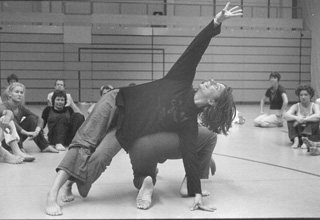
| |
|
|
description
Skinner Release Technique
Skinner Releasing Technique (SRT) is an innovative
approach to dance training developed by Joan Skinner in the early
1960s. SRT utilizes image guided floor work to ease tension and promote
an effortless kind of moving, integrated with alignment of the whole
self. Tactile exercises are used to give the imagery immediate
kinesthetic effect; spontaneous movement is frequently evoked by
imagery and movement studies. The images are metaphors for movement
principles within the natural laws of relativity. The guided poetic
imagery triggers spontaneous improvised movement. SRT smoothly
integrates technical growth with creative process.
Contact Improvisation
The workshop will offer studying the stillness
(listening and giving in to gravity) and observing the reflexes at work
by following the natural laws of movements. We are going to develop
skills by gathering information with the senses and practicing simple
moves that support safety and trust when taking physical risks. The aim
is to have a deeper understanding of the principles of CI and by
practicing the dance we will learn about composing with a sense of
knowing.
bio
Eszter Gál is a dancer, teacher and choreographer,
currently living in Budapest and a member of L1 Independent Dancers
Partnership. She studied physical education and physiotherapy in
Budapest, and dance in Arnhem, The Netherlands. Since 1993 she has been
creating her choreographed and improvised works and she regularly
teaches, leads and participates in international performance projects
and festivals in Europe, Russia and in the US. She is a certified
Skinner Releasing Technique Teacher and taught SRT in Hungary,
Slovakia, Holland, France and Seattle (USA). She was the chief
organizer of the 15th ECITE (European Contact Improvisation Teacher's
Exchange) in 2000 July in Budapest and she has been the artistic
director of Kontakt Budapest International Improvisation Festival since
2002.

|
|
Henry Montes
UK

| |
|
|
bio
Jeremy Nelson trained at The London School of
Contemporary Dance and went on to dance for The Siobhan Davies and
Second Stride Dance companies in London before coming to New York in
1984.
He was a dancer with The Stephen Petronio Dance
Company in New York from 1984-1992, returning as guest soloist in 1995.
In 1991, he won a New York Dance and Performance ("Bessie") Award for
outstanding performance with that company and in 2004 was a recipient
of a John Simon Guggenheim Memorial Fellowship for choreography. He was
an artist-in-residence at Movement Research in 1994/1995 at Dance Space
Center in 2003/2004.
He now works as an independent choreographer, teacher
and dancer. He has performed in the work of David Zambrano, Mia
Lawrence, Luis Lara Malvacías and Susan Rethorst as well as in his own
work. He has also worked with contact improviser, Kirstie Simson in an
improvisational group and performed in installation-improvisations
organized by Luis Lara Malvacías.
He is a member of the teaching faculty at Movement
Research in New York and a guest artist at Connecticut College. In the
United States, he has taught as part of the American Dance Festival,
and at various universities including New York University Tisch School
of the Arts and Bennington College. For the last eighteen years, he has
been teaching classes and workshops all over the world He has been presenting and performing his
choreography in New York since 1994, and has shown his work several
times at Movement Research at Judson Church and in the Lincoln Center
Out-of-Doors series. He has been produced on five occasions to create
work in shared programs for various New York venues including Danspace
Project at St Mark's Church in 1995, 1996 and 2000, and PS 122, in
1998. In 1999 he presented Morphylactic, a collaborative choreography
with Luis Lara at Dance Theater Workshop. He has shown a full evening
of his own work at Danspace Project at St. Mark's Church in 2002 and
again in November 2004.
He has also performed his work in various countries,
including Canada, Chile, England, Germany, Japan, New Zealand, Spain
and Venezuela. Performances in 2005 included The Full Moon Festival in
Oulo, Finland; The Riley Theatre in Leeds, England; Pomona College in
California; Montevideo Sitiada Festival in Uruguay; Rafaela and Buenos
Aires, Argentina; and Danzalborde Festival in Valparaiso, Chile. He has been commissioned to create works on companies
such as Espacio Alterno in Caracas, Venezuela, Xoroftes in Athens,
Greece, Ricochet Dance Company in London, England and Footnote Dance
Company in New Zealand and in 2003 created "The Fact that it goes Up"
for Phoenix Dance Company in Leeds, England. It was performed as part
of a national tour in 2003 that included venues such as Sadler's Wells
Theatre in London. He has studied Klein TechniqueT with Barbara Mahler
and Susan Klein for the past 20 years, and is certified to use their
technique as a theoretical basis for his contemporary technique
classes. Other studies over the past several years thqat influence his
teaching include Alexander TechniqueR with June Ekman, Bodymind
CenteringR with RoseAnne Spradlin and ongoing studies in Contact
Improvisation, including with Kirstie Simson and K.J. Holmes.
description
Contemporary Technique
The classes are influenced by Nelson's 18 years of
continuing study of in the alignment work of Barbara Mahler and Susan
Klein, and by more recent studies in Alexander TechniqueR, Contact
Improvisation and Bodymind CenteringR. The warm-up focuses on our
skeletal structure to access the deep supporting muscles of the body,
allowing mobility and suppleness in the superficial muscles. The class
emphasizes the connection to and use of the floor, and encourages a
deepening awareness of the whole body as a way to learn and to develop
dynamic, articulate and expressive dancing. The class builds from
simple exercises to phrases of movement that involve moving boldly,
covering lots of space, taking chances off balance and finding a
strength, specificity and ease in our dancing.

|
|
Jochen Roller
Germany
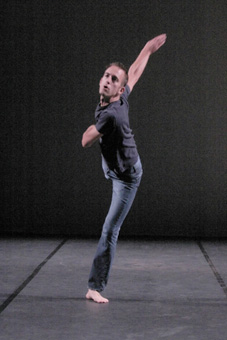
| |
|
|
description
Laban technique for dancers
In this composition class, dancers receive a basic
introduction into the movement system of Rudolf Laban. Unlike most
Modern Dance techniques, Laban is a way to organize space by moving in
a highly individual way. The class will present different models of the
dancer's space (,Choreutik') and show the possibilities of developping
choreographic tools out of this model.
For intermediate dancers of all styles.
bio
Jochen Roller, born 1971 in Berlin, studied classical
ballet at the Berlin Opera and choreography at the Laban Centre in
London. He has been working with many different choreographers as well
as creating his own pieces. Last works include the solo-triology
,perform performing' (2002, 2003 and 2004) and ,mnemonic nonstop', a
duet with Martin Nachbar.

|
|
Ilanit Tadmor
Israel
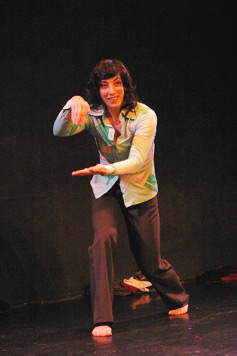
| |
|
|
description
P(L)AY ATTENTION Improvisation course
The course will gives the students a variety of tools
for starting step by step understanding how to create composition in
real time, how to develop their own language and how to communicate the
dance out side to their partner and to the audience.
These tools can be used for creating solo, duets and group improvisation.
Through working with sensations, with different skills
of the body and connecting all that we do through the awareness of the
mind.
We will work in simple structures and inside of them
we will learn more about the process of making a decision in every
minute. In every class we will research different team that will open new doors to our dance.
Using games and playfulness to find our enjoyment in our dance.
bio
Ilanit Tadmor- artistic director, choreographer and dancer
Israel- Tel Aviv
An independent creative artist since 1996.
Graduate of the Jerusalem Rubin Academy of music and
dance and also of the Hebrew University, Jerusalem where she studied
theatre and musicology. She is the Winner of the 'excellence in performance' prize in the Gvanim b'mahol (Shades in Dance) festival in 2000.
Manager and the artiest director of "PLAY" a school for
dance-improvisation and theater in Israel for professional and not
professional dancers. 2005-6
The Artiest director and founder of "BUA Dance Company" who preformed in Israel and the Far East .2002-2004
Awarded by the Israeli Government artistic scholarship as exchange artist to Taiwan. 2001-2002
Founder and manager of "Improbiza Ensemble" (1999-2003)
House Artist of the "ZIRAH" theater in Jerusalem 1998-1999.
She is continuously is invited to teach and perform in
Europe (Switzerland Spain, Ireland, Germany, Austria, and Russia) and
Far East, creating improvisation and dance- performances. In the last summer she was invited to create a dance
for "Echo-Echo" Dance Theater Company in Ireland called "Resonance"
that preformed in different places in Europe.
Her last dance peace called "PLAYSTATION" is preformed in Israel these days.
Today she lives in Tel Aviv, and in her school (Play) there are more than
70 students, learning in different programs.

|
|
Sahar Azimi
Israel
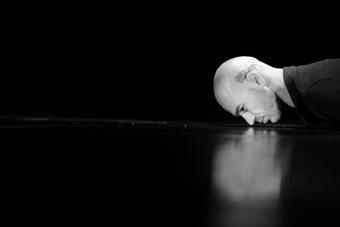
| |
|
|
description
technique
The class goe's out of the classic techniqe and uses
it for the terminology and methodology, we will use impro techniqes,
yoga, feldenkrise, Gaga naharin and some new principles I use myself in
my work.
The class is only for traind dancers who are willing to explore and take the time for listning for their body.
Solo class
The class will be a condenced lab for a solo work. Every meeting is for two hours. In every meeting we will work on one of the following:
Creative writing, music, space, momement choices, theatrical aspects and cet.
The participents must be trained dancers who wants to explore different ways of search and composition .
Every one of the participents should prepear:
1 sentence of at least 25 words about their solo / idea
3 choices of music
An object they want to use ( subject to choice)
A costume ( if neecesary for the piece)
A blank notebook ( you can also use a scatchbook)
At the end of the workshop we will hold an open studio performance ( please check if there is a big studio we can use for that)
Every solo should be no longer from 3 min'
bio
Sahar Azimi was born in August 1974 in Hadera That Lies
IN the Center of Israel. After his military service in 1994 he joined
Inbal Dance Theater and worked with Margalit Oved Marshall, later this
year he danced in Koldemama Dance Company with Moshe Efraty as the
artistic director and worked also with Anat Daniely, Daniela Michaeli
and more. In 1995 Sahar joined the Bat Sheva Ensamble with Ohad Naharin
and Noeni Perlov as the artistic directors and danced the pieces of
Jiri Kilian, Angelan Perljocaj, Linda Gudro, Lara Barsaqe as well as
Ohad naharin's. in 1998 sahar left the Bat Sheva Ensamble and started
his way as an independent dancer. He danced with many choreographers
since then until now days , Barak Marshall, Noa Dar, Emanuel Gat, Ronit
Ziv, Dededance company, Vertigo Dance Company and Javier De Frutos.In
1998 sahar won the America Israel foundation scholarship for dancers.In
1999-2000 sahar worked as a therapist with autistic people in a village
for life in Israel, there he met Itzik Vingerten and was invited to
join the cast of "then we hugged" that later won the prize for the best
play in Aco festival for different theater. During the years 2000 -
2001 sahar worked with "Clipa" theater with the artistic directors Idit
Herman and Dimitry Tulpanov. In the 2000 sahar created his first solo
"Hasufit" to the 'Intimadence' festival in Tmuna theater In tel aviv,
in 2001 sahar created a quartet for 3 dancers and an opera singer "
Mara" in the Du Oman festival in Habima - the national theater of
Israel.In November 2002 sahar premiered "itisasitis" , a duet with an
actress in the Curtein UP festival in Suzan Dellal Center that was also
invited to perform in Sau Paulo for the SESC dance festival/ Fabrica
Europe festival and in Croatia. In November 2003 Sahar premiered " So
said Herzel" in Curtain Up Festival and performed with this piece in
Beograd, Budapest, uzes (france),Lossane,Croatia and Germany . In
October 2004 sahar Joined Svetlana Livshits and together they created "
White Dance " - a piece presented in the sea and on the beach and put
together dance, visual arts, music and text, white dance participate
the contest in Aco festival for different theater. In November 2004
sahar premiered " Now I want to forget" in Curtein Up festival And
recived good revies and success. In February 2005 Sahar premiered the
solo "interpretation" in the ADC in Kyoto and the session house in
tokyo, his last piece " living room in six parts" took part in "x-po"
in the 'Lab' in Jerusalem and " Curtain up 2005" Sahar also teach in
Israel and around the world. Sahar won the prize for young
choreographers from the minister of culture and the department of dance
for 2005. sahar also won the support of Teva industries for 2005.

|
|
Juan Domingues
Spain

| |
|
|
description
laboratory
I consider choreography as a whole, from the moment I
start thinking about it, writing down those thoughts, to its
materialization and physicality, rewriting those thoughts down,
procedural trash, that banana I eat while deciding what ideas I should
abandon, up to the materialization of the whole choreographic process.
I am especially interested in the codification of the choreographic
process as an end in itself. I basically work with the concepts of
time, process and writing. Time at different levels: the language
level, time referred to the action as it is happening, time in the
writing process and cinematographic and photographic time. Regarding
process, I try to get the audience involved in the continuous flow of
the creative process. Regarding writing, I am interested in the piece
of writing transformed into an image, and the relationship between this
piece and the action. I am interested in presenting a constant
multidisciplinary transition between codes of literature, video and
dance.(drama)
I want the audience to perform a double reading. On the one hand I want
the audience to read the work in progress. On the other hand I would
like my audience to interpret the actual code, drawing bridges and
using other codes. I am interested in alternating elements from everyday
life, biography and fiction biography, switching from dreams to reality
and to meta-linguistics in a constant relation to the building process
and the transformation on stage. I try to give every fantasy an actual chance on stage.
I am interested in de-contextualizing part of the reality, trying to find the fragility this fact produces.
I give equal value to success and failure.
I need to manipulate what is real and concrete. I look for a
transformation of reality that allows a new reality, close and
concrete, far away from the abstract.
So the idea is to make the participants enter in all
this concepts through practical exercises from the first day and build
different situations that they will formulate with the rules I will
propose to them. From the very first day we will build simple actions that will conclude in a more complex choreography organisation.
The idea is to share responsibilities in an open process of who to generate choreography in different ways.
Juan Domínguez, Valladolid 1964.
Juan is performer and choreographer and studied
ballet, contemporary dance and video in Spain and USA. He received
several grants to study at Movement Research in New York, city where he
also studies different techniques and yoga. Since 1987 he works as a
performer with the choreographers: Blanca Calvo, Carmen Cortés, Olga
Mesa, Inaki Azpillaga, Cesc Gelabert, Ana Buitrago, La Ribot, Cuqui
Jerez, Gilles Jobin, Jérôme Bel, Xavier Leroy and Tino Shegal. He works
as artistic assistant with: La Ribot, Gilles Jobin, Carmen Cortés, Olga
Mesa and Cuqui Jerez. Since 1993 he teaches classes and workshops and
since 1992 he develops his own work collaborating with: Blanca Calvo:
Los Juan caballos1992, Inaki Azpillaga: 7 montanas y 7 ríos video
directed by Utray and Lamadrid 1993, Ana Buitrago: Retazos 1996, Susana
Casenave: Peces 1996, and Carmen Cortés: Así que pasen 100 Anos 1998.
Individually he creates the videos: UN JARRO DE AGUA FRÍA 1993, BRADOU
1994, JARABE TAPATIO 1995. The pieces: POLLO DIRECTAMENTE 1995, EL
PELIRROJO 1997, THE TASTE IS MINE 1999, ALL GOOD SPIES ARE MY AGE 2002
AND THE APPLICATION 2005, SEVEN ATTEMPTED ESCAPES FROM SILENCE 2005.
He is artist in residence in Podewil (Berlin) 2004 and 2005.
Since 2003 he is Director and Curator of the season In-Presentable at La Casa Encendida, Madrid.

|
|
Jacques van Eijden
Holland

| |
|
|
description
Somatic Movement Coaching Support yourself!
This class teaches a somatic approach to dance technique.
It is appropriate for dancers at all levels who want to increase their movement awareness and focus.
The Floor Kata embodies the idea of refinement. The
adding of more and more specific Somatic Movement Coaching principles
to the movement sequence, cultivates understanding of dance technique
and discipline.
It teaches us how we organise our selves in space and time.
The sessions will start with a general warm-up,
enlivening mind and body and will then move into the teaching of the
actual 'Kata', a very specific movement sequence performed on the
floor.
Through the performance of the Floor Kata, techniques for flow of
movement, balance, coordination, breathing and focus are developed. Done properly, The Floor Kata is an excellent physical as well as mental exercise.
Note: The word 'Kata' is derived from the Kanji characters meaning 'shape', 'cut' and 'earth' or 'soil'.
A Kata is literally a 'shape which cuts the ground'.
The balance between support and expression as well as the direction and
flow of movement give the Floor Kata its specific character. Somatic Movement Coaching Express yourself!
Exploring the somatic principles of Balance and Integration
This improvisational dance class gives you a lot of
space for expression.
Students will perform structured improvisations and learn how to coach
each other using the Soma Mapping method developed for Somatic Movement
Coaches.
Note: The Soma Map offers an overview of all areas.
We will choose the ones that will be of interest to the group of
participants. Balance
1. Balancing Externally: the dynamics of movement.
Exploring the structural aspects of movement; like the skeleton-muscular and the articular systems.
2. Balancing Internally: the quality of movement.
Exploring the functional aspects of movement; like the visceral and cardio-vascular systems.
Integration
The way we Integrate our movements in time and space gives meaning to our dance.
3. Organising our Movements: the flow of movement.
Body, time and space: exploring regions and rhythms, paces and phrases, layers and levels.
4. Principles of Guidance: the focus of movement.
Exploring our senses and perceptions, how they guide our actions and help express our intentions.
5. Understanding Development: the unfolding of movement.
Exploring developmental patterns, forces and underlying reflexes and responses.
Together they expand are possibilities to express our selves in movement.
bio
Born August 3, 1957 in the Netherlands
Jacques van Eijden, dancer and pedagogue at heart, has
moved through the fields of psychology, movement, the arts, dance, and
architecture around the world for more than three decades. His movement
training and performance experience in Europe, the USA and Australia
with (a.o.) Elaine Summers, Russell Dumas, Marsha Paludan, Pauline de
Groot, and especially John Rolland established his affinity with
improvisation, creative dance and somatics. Later his interest in health issues in the arts took
him even further into this field especially during his collaboration
with Bonnie Bainbridge Cohen in running the first Certification
Programme of her work in Europe. In his work he has integrated principles of several movement and meditation disciplines.
Western disciplines such as Gymnastics, Hawkins based
Pauline de Groot technique, Contact Improvisation through his studies
with Nancy Stark Smith. Todd Alignment, Release- Technique with Marsha
Paladin, Nancy Topf and John Rolland. Eastern disciplines such as
Iyengar Yoga, Sitting Practice drawn from the Tibetan and Zen Buddhist
traditions, T'ai Chi and Tai Jitsu.
He developed somatic approaches to movement and
aesthetics of the Amsterdam School of Higher Education in the Arts
(AHK), at the School for New Dance Development (SNDD) and the
Department of Creative Dance. As one of the teachers of somatics and
head of the somatic guidance team at the SNDD for 10 years, Jacques van
Eijden brought a somatic view to dancers and dance makers in the field
today. He co-founded Stichting Vie Male in 1988, a dance productions
foundation based on the role of body intelligence in the creation of
dance, that later influenced the formation of the Institute for Somatic
Movement Studies in 1999. His work continues to bridge different disciplines,
transforming Body Intelligence into art, health, quality of life and
effective action.

|
|
Natanja den Boeft
Holland
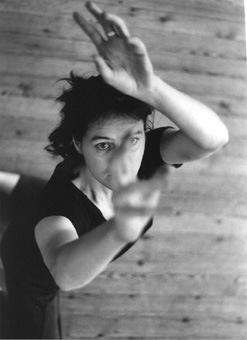
| |
|
|
description
Contact-improvisation and the use of Ki
Contact-improvisation and the use of Ki
The japanese word ki is a word used for energy: more
specifically the living energy that supports all forms of life and is
present in the world around us as well as in our bodies and minds.
In Aikido, a japanese martial art, four principles of
ki - keeping one point, relaxing completely, extending ki and keeping
the weight underside - are defined and trained. In dance they are
useful tools for dealing with the flows of energy in one's body and in
dancing with partners. In this workshop we will practice the energetic
principles offered by Aikido and use them in exercises on basic skills
such as carrying, falling, lifting and flying, while maintaining
physical contact.
In improvisation we will transform the exercises into playful encounters.
Contact-improvisation and a performative state
In this workshop we will look at a way of making
contact-improvisation performative. We will focus specifically on two
elements: multi-tracking and choice-making.
Multi-tracking is a term borrowed from music: having
more than one track open at the same time. For dance this means being
able to focus on more than one element of what is going on at the same
time.
Choice-making is a rich and sometimes undefined
proces. We'll look at the sources of choices: the touch, our culture,
memory, theatrical triggers and diverse physical sensations, and at how
to integrate these choices in a contactduet.
With all these elements - and being in physical contact most of the time - we will improvise, play and watch each other.
This workshop is open for people with solid experience in c.i. and an interest in performance.
bio
Natanja den Boeft is a freelance dancer/teacher/artist
based in Amsterdam.
She has been teaching since 1987, in (contact)improvisation, technique,
composition and performance skills, to professional dancers and actors,
as well as amateurs in a wide range of backgrounds.
From 1992-1999 she was a staffmember at the Theaterschool Amsterdam,
department 'School for New Dance Development', in improvisation and
contact-improvisation. She regularly teaches workshops and guest
classes at various dance-academies and studios throughout Europe and in
Japan. In 1986 she started her ongoing practice in Aikido. She
practices and teaches at the Shin Budo Kai dojo in Amsterdam.
The practice of Aikido has over the years become an
important influence in her dancework, especially in
contact-imprvisation, for its use of energy, centered strength, space
and direction.
Besides teaching she makes films and site-specific performances, she writes and photographs.

|
|
Alexander Pepelyaev
Russia
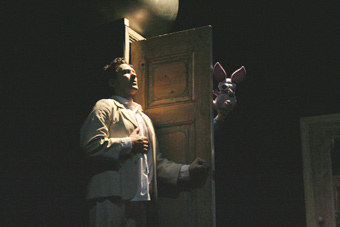
| |
|
|
description

|
|
Alexandra Konnikova & Albert Alberts
Russia
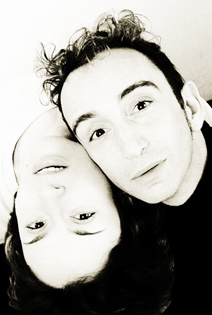
| |
|
|
description
|
|
Darya Buzovkina
Russia
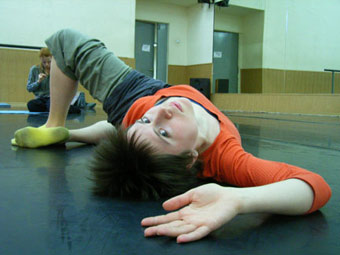
| |
|
|
description
|
|
Taras Burnashev
Russia
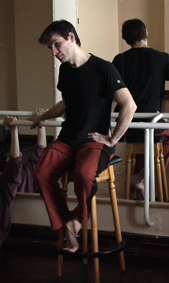
| |
|
|
description
technique for beginners
The classincludes basic elements of body work such as
work with floor, weight and release, and simple dance combinations. The
class mignt be interesting not only for begginers but for intermediate
dancers. Composition Lab
The workshop is bazed on two interaction aspects -
Space and Time.
Lab is going to research formal ways of organizing connections between
space and dancers in it. Time is an important instrument for organizing
dance structure. It defines how the composition is situated not only in
space. bio

|
|
Tatiana Gordeeva
Russia
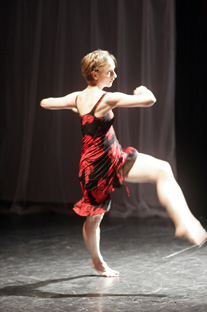
photo: Peeter Jalakas
| |
|
|
description
technique
The class reflects the experience gained from modern
and release based dance intensives and a broad stage practice including
work in the Kremlin ballet for 9 years, Sasha Pepelyaev's project for
10 year and 7-year teaching; as well as personal exploration and
research.
The class challenges the process of crystallising the
authentic movement's algorithm by designing the relationships between
mind and body and searching for an effective and efficient use of the
body potentials.
The main aspects of the class are:
dynamic alignment of the skeleton
body' volumes
body's parts articulation
dynamic of movements
The lesson includes simple exercises which can serve as
a platform for practicing any principals of any dance styles. Those
will be followed by more complicated dance phrases where such
principles as reason and circumstance, fall and balance, travelling in
the space, inertia and weight and coordination of jump will be
applied." bio
Tatiana Gordeeva started to dance at the age of 6. She
graduated from Moscow Ballet Academy in 1990 with the diploma of
excellence. She worked for the Kremlin State ballet as a soloist for 9
years. Tatiana finished her ballet dancer's carrier in January 1999. In
1995 Tatiana was invited to joint Sasha Pepelyaev's project "Kinetic"
(now Apparatus Theatre Group). Since then, she has taken part in all
company's performances.
As a dancer Gordeeva participated in few classical and contemporary dance competitions:
Perm, Russia, 1994 - III Prize, "Arabesque-94";
Luxembourg, 1995 - diploma;
Paris, 1994 - diploma, 1996;
Paris, 1997 - "Adami" - Individual Performance Award, 6-e Rencontres Choreographiques Internationales De Seine-Saint-Denis.
Her solo performance "Ichbinbeidir" was a nominee of the National Theatre Award "Golden Mask" in 2002.
Tatiana works as an educational programme manager in Moscow Dance Agency TSEH since 2001.
She is taking her attestation for the 1 Kyu grade in Ki
Aikido at the end of May, The Ki Federation of Great Britain, Moscow
branch, Sensei D.Popolov, 2nd Dan.

|
|
Michael Ivanov
Russia
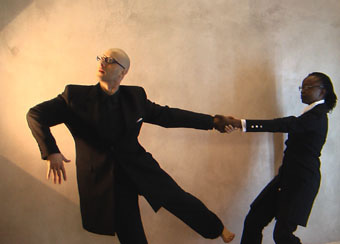
| |
|
|
description
laboratory
bio

|
|
Tatiana Fateeva
Russia
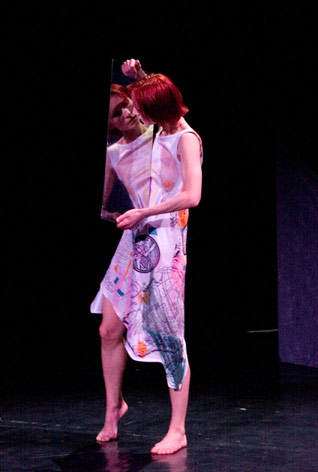
| |
|
|
Desription
technique for beginners
bio

|
|
Emmanuelle Gorda
Russia/France
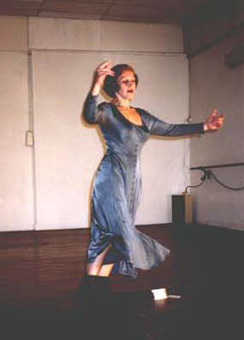
| |
|
|
description
technique for beginners
bio

|
|
Wally Cardona
USA
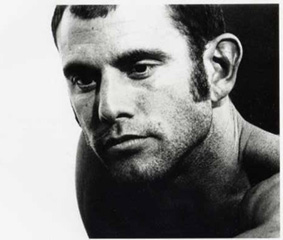
photo: Arzcensek
| |
|
|
description
technique
"This class utilizes my 16 years of study with Susan
Klein and Barbara Mahler, emphasizing anatomic realities as a way to
connect to one's entire body on a practical level. Using the floor as
an ever-present fulcrum from which to move into space is addressed as a
reality while also acknowledging its metaphoric connections to how an
individual moves through the world. Each participant is given the
opportunity to work at their own speed, address personal patterns and
begin to know - through body felt experience - where they are at each
and every moment. This leads to the potential of moving from an
identity underneath "personality". Putting this potential into a
creative dance practice takes place in the class called PERFORMANCE. " Performance
"I view this class as an experiential lab, a place where the body
itself can be utilized as an entry point for the discovery of
unexplained phenomena. Each person will practice using their embodied
knowledge to perceive, create, and navigate the moment through
movement. Dancing will take place as a group as well as individually,
with equal emphasis placed on action and observation. To get the most
out of this class, enrollment in the TECHNIQUE class is highly
recommended."
- W.C. bio
Wally Cardona was raised in California and New Mexico.
A competitive gymnast ages 7 through 9 and a clarinetist ages 11
through 15, he began dancing at age 19. In 1986, he moved to New York
City to attend The Juilliard School (B.F.A.). The following summer,
invited by (and under the tutelage of) Benjamin Harkarvy, Cardona
attended the Ballet Project at Jacob's Pillow and there danced in a
work by Ralph Lemon. He subsequently danced in Lemon's Company until
1995. During this time, Cardona's first work, Solo Alone/Add One, was
performed at the Cannes Festival and Judson Church/Movement Research in
New York City. In 1995, he choreographed his first collaborative suite
of dances, Made In Voyage. Commissioned by Danspace Project, a
solo-version of Made In Voyage was performed in six countries and
selected for the 1996 Plateaux - Biennale Nationale de Danse du
Val-de-Marne. Later that year, French choreographer Hervé Robbe invited
Cardona to create a new work - a double purpose/a double emploi - for a
cast of four American dancers and Robbe's company, Le Marietta Secret.
The following year, Wally Cardona Quartet (WC4) was founded and, in
1998, debuted at The Joyce Theater. Since then, Cardona has created
eight works for WC4, four of them evening-length. Commissions include
Brooklyn Academy of Music's Next Wave Festival, Portland Institute for
Contemporary Art's TBA Festival, Jacob's Pillow Dance Festival, Dance
Theater Workshop, Danspace Project, Symphony Space, Ricochet Dance
Company, Company OFF/ Trafó, and Paradigm. International engagements
include France, Germany, Austria, Belgium, Hungary, Sweden, Denmark,
Australia, Portugal, Argentina, Chile, Korea, and Mexico. Cardona's
choreography has been recognized with multiple awards from the National
Dance Project, the Jerome Foundation, the National Endowment for the
Arts, New York State Council on the Arts, The Fund for U.S. Artists and
BUILD - a program of the New York Foundation for the Arts, and a single
award from The Multi-Arts Production Fund. Classes are inspired by
Cardona's ongoing studies with Barbara Mahler and Susan Klein,
performance work with Deborah Hay, practice of improvisational forms,
and history with traditional/classical dance forms. He resides in
Brooklyn, NY.

|
|
Jeremy Nelson
USA

photo: tom brazil
| |
|
|
description
Contemporary Technique
The classes are influenced by Nelson's 18 years of
continuing study of in the alignment work of Barbara Mahler and Susan
Klein, and by more recent studies in Alexander TechniqueR, Contact
Improvisation and Bodymind CenteringR. The warm-up focuses on our
skeletal structure to access the deep supporting muscles of the body,
allowing mobility and suppleness in the superficial muscles. The class
emphasizes the connection to and use of the floor, and encourages a
deepening awareness of the whole body as a way to learn and to develop
dynamic, articulate and expressive dancing. The class builds from
simple exercises to phrases of movement that involve moving boldly,
covering lots of space, taking chances off balance and finding a
strength, specificity and ease in our dancing. bio
Jeremy Nelson trained at The London School of
Contemporary Dance and went on to dance for The Siobhan Davies and
Second Stride Dance companies in London before coming to New York in
1984.
He was a dancer with The Stephen Petronio Dance
Company in New York from 1984-1992, returning as guest soloist in 1995.
In 1991, he won a New York Dance and Performance ("Bessie") Award for
outstanding performance with that company and in 2004 was a recipient
of a John Simon Guggenheim Memorial Fellowship for choreography. He was
an artist-in-residence at Movement Research in 1994/1995 at Dance Space
Center in 2003/2004.
He now works as an independent choreographer, teacher
and dancer. He has performed in the work of David Zambrano, Mia
Lawrence, Luis Lara Malvacías and Susan Rethorst as well as in his own
work. He has also worked with contact improviser, Kirstie Simson in an
improvisational group and performed in installation-improvisations
organized by Luis Lara Malvacías.
He is a member of the teaching faculty at Movement
Research in New York and a guest artist at Connecticut College. In the
United States, he has taught as part of the American Dance Festival,
and at various universities including New York University Tisch School
of the Arts and Bennington College. For the last eighteen years, he has
been teaching classes and workshops all over the world at places
including: ImPuls Tanz, Vienna
International Summer Dance School, Tokyo
Sasha Waltz Company, Berlin
PARTS and Rosas Company, Brussels
Siobhan Davies and Company, London
Ballet Rambert, London
London School Of Contemporary Dance, London
Northern School of Dance in Leeds, England
S.O.A.P. Dance, Frankfurt
Espacio Alterno, Caracas, Venezuela
He has been presenting and performing his choreography
in New York since 1994, and has shown his work several times at
Movement Research at Judson Church and in the Lincoln Center
Out-of-Doors series. He has been produced on five occasions to create
work in shared programs for various New York venues including Danspace
Project at St Mark's Church in 1995, 1996 and 2000, and PS 122, in
1998. In 1999 he presented Morphylactic, a collaborative choreography
with Luis Lara at Dance Theater Workshop. He has shown a full evening
of his own work at Danspace Project at St. Mark's Church in 2002 and
again in November 2004.
He has also performed his work in various countries,
including Canada, Chile, England, Germany, Japan, New Zealand, Spain
and Venezuela. Performances in 2005 included The Full Moon Festival in
Oulo, Finland; The Riley Theatre in Leeds, England; Pomona College in
California; Montevideo Sitiada Festival in Uruguay; Rafaela and Buenos
Aires, Argentina; and Danzalborde Festival in Valparaiso, Chile. He has been commissioned to create works on companies
such as Espacio Alterno in Caracas, Venezuela, Xoroftes in Athens,
Greece, Ricochet Dance Company in London, England and Footnote Dance
Company in New Zealand and in 2003 created "The Fact that it goes Up"
for Phoenix Dance Company in Leeds, England. It was performed as part
of a national tour in 2003 that included venues such as Sadler's Wells
Theatre in London. He has studied Klein TechniqueT with Barbara Mahler
and Susan Klein for the past 20 years, and is certified to use their
technique as a theoretical basis for his contemporary technique
classes. Other studies over the past several years thqat influence his
teaching include Alexander TechniqueR with June Ekman, Bodymind
CenteringR with RoseAnne Spradlin and ongoing studies in Contact
Improvisation, including with Kirstie Simson and K.J. Holmes.

|
|
Juliette Mapp
USA
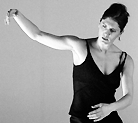
| |
|
|
description
technique
Using the luxury of many continuous days dancing
together we will take the time to investigate
different states of awareness. Each class will be
three-fold beginning with a guided improvisation to
inspire the imagination to expand into the unique life
of different parts of the body. This will be followed
by dancing within some technical forms to support our
range and work as dancers. Class will conclude with
learning a phrase to integrate concepts of weight and
lightness, initiation and intention. We will also use
the process of learning a combination to observe how
we retain "set" material. The technical work and
combination will be specifically structured to build
our knowledge of individual physical patterns that may
be blocking us from deepening the use of our selves as
artists. The merging of the unconscious life of
movement through improvisation and conscious attention
to the the physical imagination and all its richness
is part of the energizing practice we will explore
every day in class.
bio
Juliette Mapp is a dancer, teacher and choreographer
based in Brooklyn, NY. After graduating from Sarah
Lawrence College in 1993 Juliette went on to dance for
numerous choreographers including Stephanie Skura, Pat
Graney, Orjan Andersson, Neil Greenberg, Vicky Shick,
Irene Hultman, John Jasperse and most recently
Deborah Hay. Juliette received a New York Dance and
Performance award (i.e. Bessie) for her dancing with
Mr. Jasperse in 2001. Juliette was an assistant to
Mr. Jasperse, helping create dances on Baryshnikov's
White Oak Project and Ballet Lyon. Juliette teaches
throughout the world and in NYC she regularly appears
at Movement Research, Dance New Amsterdam, Trisha
Brown Studios and Hunter College. Juliette also makes
her own solo and group dances. In April, 2005
Juliette premiered her sixth anti-war dance, "one", a
piece for 70 members of the New York dance community
presented by Dancespace Project at St. Marks Church.
Juiette's dancing and teaching is influenced by her
study of the Alexander Technique with June Ekman,
Body-Mind Centering with Rose-Anne Spradlin, Skinner
Releasing with Joan Skinner and Kinetic Awareness with
Elaine Summers.

|
|
Virpi Juntti
Finland
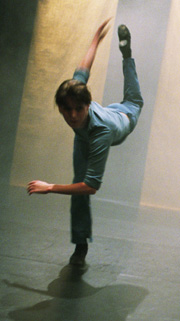
| |
|
|
description
technique
I don't teach any particular technique, but my classes
consist of things that I have found important in my own work as a
dancer and performer. I emphasize the wholeness of movement, which to
me means taking advantage of the movement of the whole body, all of its
different joints and vertebrae. This also involves recognizing where
the movement starts from - where its impulse is. One subject that I am
exploring is how to bind movement into fluent phrases and the benefits
of using breath in doing so, especially when the sequence requires
speed and strength. I want to teach movement that is ergonomic and
pleasant to the body, although this does not mean it is easy!
I start my class with a warm up that takes into
account all the joints of the body and e.g. wakes up the coordination
of the arms and legs. Centre floor sequences focus on loosening up the
tightness of the body and mind. Dance sequences across the floor and
the ones at the end of the class explore different ways of combining
one movement with another as well as changes in dynamics i.e. force and
breath. So I can promise a lot of articulation of arms and legs, fluid
movement of joints, bodies off balance, taking advantage of the floor
whilst moving and a whole lot of great music and fun! bio
EDUCATION
- Theatre Academy, Department of Dance and Theatre Pedagogics,
Helsinki, Finland: Master of Arts in Dance Pedagogy 2003
- Theatre Academy, Department of Dance, Helsinki, Finland: Master of Arts 1996
- Linnankosken lukio [Linnankoski Gymnasium], Porvoo Finland: Matriculation Exam 1989
has been working with Tommi Kitti, Mammu Rankanen,
Teppo Virtanen, Thomas Rydberg, Arja Tiili, Tuomo Railo, Minna Tuovinen
and Martin Heslop, Minna Vainikainen, Susanna Leinonen, Outi Järvinen
and others CHOREOGRAPHIES:
- MINETTE Dancers: Roosa Ikäheimo and Hanna Savolainen, guitarists: Rody van Gemert and
Mikko Ikäheimo 20004
- KUDELMA [FABRIC] Dancers: Carl Knif, Kaisu Hölttä, Jyrki Haapala, Virpi Juntti, 2003
- BÄNDI [THE BAND] Dancers: Maija Pajari, Inari Salmivaara, Elina Torppa, 2001
TEACHING EXPERIENCE:
- Contemporary dance courses in various places, 1995-to date:
Dance Studio Footlight, Dance Studio Tanssivintti, Dance Studio Tanssiopisto,
Theatre Academy's Dance Department and Dance and Theatre Pedagogics Department,
National Opera's Ballet School, Helsinki Dance Company, Latvijas Kulturas Akademija
- Choreographer Tommi Kitti's assistant in National Opera's Ballet School
Dance production STILL LIFE FOR FOUR DANCERS, spring 2004
- Choreographer Jens Walentinsson's assistant in Theatre Academy
Dance production BALANCE 01 for acting students, autumn 2001

|
|
Sylvain Prunenec
France
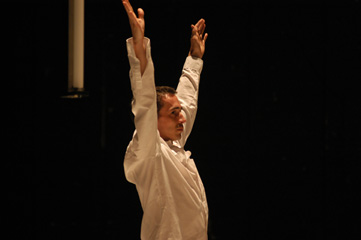
| |
|
|
description
technique and composition/improvisation
As a dancer, I worked with choreographers for who
writing and composition are the mainspring of their creations : Odile
Duboc (Fr.), Dominique Bagouet (Fr.), Trisha Brown (U.S.A.)...
Each one with his own way, has reinforced my liking for abstaction and
danced mouvement.
In my own work, I try to reconsidere the constituent elements of my
practice of dance : jump, walk, run, breath, balance... to play with
this elements and to reduce them to their most basic dynamic function.
Length, quality and direction compose the mouvement.
During the class, the exercizes and choreographic
phrases involve the dancer more in a dynamic motion than in the form. I
like to play with segmentation and compactness of the body. Degrees of
tension and release induce the musicality and also the presence of the
dancer.
During workshop, the same finality is researched through improvisation
and composition.
bio
Sylvain Prunenec collaborated with numerous
choreographers, amongst them Odile Duboc, (Insurrection, Projet de la
mati?re, Pour m?moire, Brins d?histoires), Dominique Bagouet (Meubl?
sommairement, Necessito, So schnell), Trisha Brown (One story as in
falling), Herv? Robbe (Id, V.O.), and he?s also dancer for Nathalie
Collant?s, Lo?c Touz?, Boris Charmatz?
Moreover, he took part in the Christian Rist?s piece
dedicated to Arthur Rimbaud and to C?lia Houdart?s creations.
For the cinema, he is an actor for Olivier Ducastel and Jacques
Martineau in Jeanne et le Gar?on formidable (Jeanne and the fantastic
young man) (1998) and for Jean-Paul Civeyrac in Toutes ces belles
promesses (So many beautiful promises).
Since 1995, Sylvain Prunenec has been creating his own
pieces, with the collaboration of musicians : Verso Vertigo (Fondation
Cartier, Paris, 1996), B?ti (Beaubourg, Paris, 1998) with Fred Bigot,
electronics musician Zarb (Blois, 2000), La Finale (IRCAM, Paris,
2002) and Fronde Ethiopia (Festival Montpellierdanse, 2002) with
Fran?oise Rivalland, percussionist.
Since 2000 he has been weaving links with African
artists, the Ethiopian Dance Company Adugna, and Studios Kabako,
Faustin Linyekula?s Congolese Company. Together they created Si c?est
un n?gre/autoportrait for Le Vif du Sujet at the Avignon Theater
Festival (2003) and are developing a project between Ethiopia and Congo
entitled Kin-Addis / Chantiers chor?graphiques.
In 2003/2004, a resident artist at the Forum, the
Blanc-Mesnil covenanted theater, he puts up two pieces dealing with the
dismembered body : Effroi solo (2003) and Redoux for six interpreters
performed in Beaubourg, Paris, 2005.
Actually, he?s beginning a new research to create Lunatique (solo) and
Ligne de fuite for 2006/2007.

|
|
Brahim Bouchelaghem
France
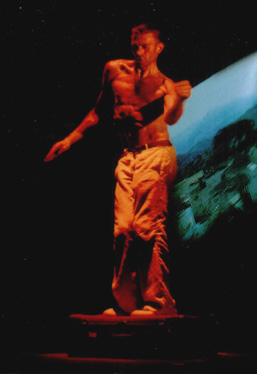
| |
|
|
description
hip-hop
Brahim will work on :
- Hip hop technique like loock, pop and breakdance
- History of hip hop (influences and evolution)
- Danse improvisation (reflexion on the creation of choregraphy).
bio
Since 1984 : Discovery of Hip Hop thanks to the tranmission of HIP HOP on the channel TF1
From 1993 to 1996 : Founder of the group New Dance Street ( Roubaix )
From 1996 to 1998 : Participation of world championship
Battle of the year 96 in Germany with the company Namur break
sensation. Meeting with Farid Berki. Dancer in the company Melting Spot
( Villeneuve d'Ascq ), Meeting with the dancer Storm, Participation in
the creation État d'urgence company Funk Attitude (Tourcoing) directed
by Jean Pierre Douterling. Since 1998 : Dancer for the company Käfig (Lyon),
Creation of Récital in Maison de la danse in Lyon, Dancer for the
company 6° sens (Roubaix) with the creation Notre 6° sens.
2000 : Creation of the show Pas a Pas in South Africa for the festival Lomba in Durban.
2001 : Dancer in 10 Versions of the company Käfig ad tour in Canada.
2003 : Creation of Récréation in the show Mekech Mouchkin of the Companies Accrorap et Käfig. Creation of La Tâche - Cie Käfig
2004 : Dancer in Pourquoi pas. of Kader Attou - Accrorap, Creation of Zahrbat

|
|
Maja Delak
Slovenia
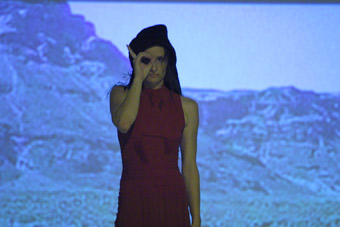
| |
|
|
description
technique
Synthesis of contemporary technique
Basic teaching goals are:
- to give body peacefulnes and awerness to be ready to move
- to to find placement in standstill on the floor and in standing and then to direct the body in space
- to develop awareness of a body in space (extensions,
opposite dynamics, directions in space defined by the limits of body
itself)
- to be conscious of the fact that the body takes a certain position in space
- to connect technical elements with shorter exercises
of improvisation that create a double relationship - placement of the
body in a place and space
- to enjoy to move
composition "The poetry of movement ~ The movement of poetry"
While we (clown and mime Andrea Ruberti and me) were
researching the material for Gina and Miovanni, we discovered that
poetry is to literature what contemporary dance is to dance art,
particularly the poetry that fascinated us at that time.
I am interested interested in the expression,
potential, thought and energy of motion, which carries its own story.
You can manipulate this story in your thoughts and get different
responses to the same suggestions. The fact that such different types
of body training as pantomime and dance can form an interesting field
for meeting on grounds of matching contents is likewise interesting.
In workshops, we will explore the potential and
expression of motion created on the basis of poetry. According to
different sources, we will guide the shaping of individual materials
and develop the qualities and importance of motion in particular. We
will be looking for accurate and conscious directing of attention
towards movement and discovering personal stage space. Then we will look for was how to make interaction
between people and material, how to compose the picture with or without
poetry in mind. We will look for the ways where and how contents and
contexst meet and interact. bio
Maja Delak is choreographer, dancer, pedagogue and
driving force behind the first high school for contemporary dance in
Slovenia and other educational and research programs of Zavod EN-KNAP
as Dance Lab, Agon... Maja has long dance history. She studied at the
Secondary School of Ballet in Ljubljana, at CNDC L'Esquisse in Angers,
France and has participated numerous diverse workshops in Slovenia and
abroad.
She has extensive stage and film experience performing especially with
En-Knap Dance Company in Iztok Kovaè`s productions (Spread your wings,
you clumsy elephant, Sting and String - first touch, Codes of cobra,
Kaktus unter Strom, Perfect Step?...) and films (Narava Beso, Vertigo
Bird, Dom Svobode). She performed in short film by Hanna A.W.Slak -
"A.M.", short film by Zemira Alajbegoviè - "Fast/Slow", and in
longmetrage by Ema Kugler - "Fantom". Maja has created and toured with her own
choreographies: Manifestation of the Introvert (1995), Gina &
Miovanni (1999), 6agon (2001), Tovarishi (2001) and Mezzanino (2002).
In collaboration with Mala Kline, dancer and choreographer, Maja Delak
in 2004 created Properly Blonde as closing performance of Agon
programme. In the same yeat they collaborated with director and
designer Mauricio Ferlin and created site specific performance
Rondinella and dance duet HI-RES.
In september 2005 Mala Kline and Maja Delak presented a closing work of
Agon-Research programe, Galery of Dead Women, piece created for six
dancers and actress, based on the H. Miller`s text Hamletmachine.

|
|
Matej Kejzar
Slovenia
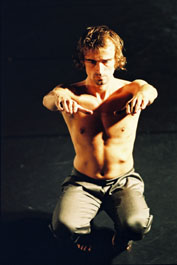
| |
|
|
description
Class starts with simple aligment exercisses applieing
Kline and Alexander techniques. As we bring our bodys to the floor, we
start with stamina exercises, moveing in and out from floor. At this
point image of body falling through space is applied. Floor combination
is build up to confronte students with diferent qualities and ways of
useing the body.
After stending we look at aligment again. Starting with exercises on
spot, we look at pelvis and spine connection as a base for any given
movement material. Students are asked to work within their body
specifics. Starting to build movement sequances traveling
through space, body awarnes is increased by deconstructing movements,
sperateing arms and legs exercises. Still focusing on body falling,
spiral becomes main focus, shifting intention from distal to inner
support.
Combination at the end fuses all pre-used movement principles playing with diferent dynamics.
Aim of class is to find optimal body placement in order to be able to shift betwen diferent movement qualities and dynamics.
bio
|
|
Anna Braslavskaya
jazz
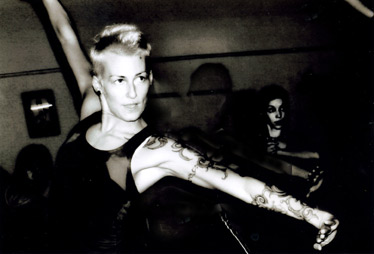
| |
|
|
|
|
Valentina Shulga
Russia
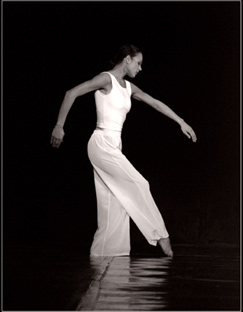
| |
|
|
description
|

